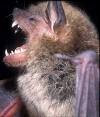The news media, movies, television, and comic books often perpetuate myths, "old-wives-tales," folklore, legends, and fears about bats that a surprising number of people believe. Bats do not get into your hair, they are not flying mice, they don't come "out of hell," they are not blind, and only three species (not in the U.S. or Canada) make a diet of blood.
Myths about bats are found in many human cultures. The ancient Egyptians believed that bats could prevent or cure poor eyesight, toothache, fever, and baldness, and a bat hung over the doorway of a home was thought to prevent the entry of demons that carried these "diseases." Bat gods were important to many pre-Colombian civilizations in central America, and bats have been used in vodoo worship in parts of Africa as well as in many parts of the Caribbean even today. The association of bats with the legend of human vampires has an uncertain origin, but since the time of Cortez and his Conquistadors, peoples of western civilization have linked vampire bats with the legendary "human" vampires of Transylvania. The writings of William Shakespeare, Robert Louis Stevenson, and others have contributed to legends that cast a veil of fear on people, as they associate bats with graveyards, death, ghosts, and goblins.
To the Chinese, bats are regarded as symbols of happiness and good fortune (health, wealth, serenity, virtue, and long life). At one time Chinese mothers would sew small jade buttons in the shape of a bat on the caps of their babies, a custom believed to impart long life. Ancient and modern-day art objects, tapestries, Imperial robes, home furnishings and the like often include bats as part of the motif.
uman" vampires of Transylvania. The writings of William Shakespeare, Robert Louis Stevenson, and others have contributed to legends that cast a veil of fear on people, as they associate bats with graveyards, death, ghosts, and goblins.
To the Chinese, bats are regarded as symbols of happiness and good fortune (health, wealth, serenity, virtue, and long life). At one time Chinese mothers would sew small jade buttons in the shape of a bat on the caps of their babies, a custom believed to impart long life. Ancient and modern-day art objects, tapestries, Imperial robes, home furnishings and the like often include bats as part of the motif.
To the Chinese, bats are regarded as symbols of happiness and good fortune (health, wealth, serenity, virtue, and long life). At one time Chinese mothers would sew small jade buttons in the shape of a bat on the caps of their babies, a custom believed to impart long life. Ancient and modern-day art objects, tapestries, Imperial robes, home furnishings and the like often include bats as part of the motif.




